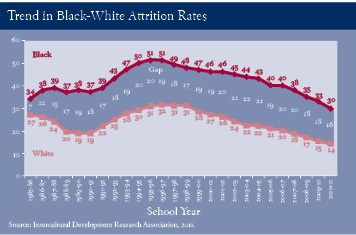• by Roy L. Johnson, M.S. • IDRA Newsletter • November- December 2011 •


For the second time in its 26-year history of reporting trends in dropout and attrition rates in
Texas public schools, IDRA’s latest study shows that less than 30 percent of students were lost from public school enrollment prior to graduation with a high school diploma. In its most recent annual attrition study that examines school holding power in Texas public high schools, IDRA found that 27 percent of the freshman class of 2007-08 left school prior to graduating in the 2010-11 school year. This is six percentage points lower than the initial rate of 33 percent found in IDRA’s landmark 1985-86 study.
For each racial and ethnic group, the study found that current attrition rates were lower than rates found in the 1985-86 study. However, the gaps between the attrition rates of White students and Hispanic students and White and Black students are higher than 26 years ago. Between White and Hispanic students, the attrition rate gap has increased from 18 percentage points in 1985-86 to 23 percentage points in 2010-11. The attrition gap between White and Black students has increased from 7 percentage points in 1985-86 to 16 percentage points in 2010-11. Additional research is needed to address the reasons for the decline in overall attrition rates and the widened disparity in attrition rates between racial and ethnic groups.




Since 1986, IDRA has conducted an annual attrition study to track the number and percent of students in Texas who are lost from public school enrollment prior to graduation from high school. IDRA was credited with conducting the first comprehensive study of school dropouts in Texas when it released its initial study in October 1986. This 2010-11 attrition study is the 26th study conducted by IDRA and the latest in a series of reports that began in the 1985-86 school year. Historical statewide attrition rates and numbers of students lost to attrition are categorized by race-ethnicity and by gender. County-level data also are provided. In addition to statewide information, trend data by county are available on IDRA’s web site at www.idra.org.
A supplemental analysis using linear regression models predicts that Texas will reach an attrition rate of zero in the year 2037, down from a prediction of the year 2040 estimated last year. At this pace, the state will lose an additional 1.6 million to 4.1 million students. (Montes, 2011)
Key findings of the latest study include the following:
- The overall attrition rate declined from 33 percent in 1985-86 to 27 percent in 2010-11.
- Texas public schools are failing to graduate more than one out of every four students.
- At this rate, Texas will not reach universal high school education for another quarter of a century in 2037.
- Numerically, 110,804 students were lost from public high school enrollment in 2010-11 compared to 86,276 in 1985-86.
- Since 1986, Texas schools have lost a cumulative total of more than 3.1 million students from our public high schools.
- Since the first study, attrition rates of Hispanic students declined by 18 percent (from 45 percent to 37 percent). Attrition rates of Black students declined by 12 percent (from 34 percent to 30 percent). Attrition rates of White students declined by 48 percent (from 27 percent to 14 percent).
- The racial-ethnic gaps are dramatically higher than 26 years ago. The gap between White students and Hispanic students increased by 28 percent. The gap between White students and Black students increased by 129 percent.
- For the class of 2010-11, Hispanic students and Black students are about two times more likely to leave school without graduating than White students.
- The attrition rates of males have been higher than those of females. In the class of 2010-11, males were 1.3 times more likely to leave school without graduating with a diploma than females.
- From 1985-86 to 2010-11, attrition rates of male students declined by 11 percent (from 35 percent to 31 percent), while the attrition rates of female students declined by 28 percent (from 32 percent to 23 percent).
The full study is available on IDRA’s web site at www.idra.org. It includes methodology, historical statewide attrition rates and numbers of students lost to attrition categorized by race-ethnicity and by gender, the supplemental analysis for reaching a rate of zero, a county-level data map, a county-level attrition rate table, trend data by county, and historical county-level numbers of students lost to attrition. The study also looks at the latest dropout studies released by the Texas Education Agency and the
National Center for Education Statistics.
IDRA has developed a number of products to guide communities and schools in improving school holding power in schools in Texas and across the nation. In its book, Courage to Connect: A Quality Schools Action Framework TM, IDRA shows how communities and schools can work together to strengthen school success in a number of areas including graduation outcomes. The book’s web page (http://www.idra.org/couragetoconnect) provides a table of contents, excerpts, related podcasts and other resources.
IDRA’s online OurSchool data portal helps community and school partners examine their school data and plan joint actions to improve school holding power.
IDRA’s one-page Quality School Holding Power Checklist provides a set of criteria for assessing and selecting effective dropout prevention strategies.
IDRA president and CEO, Dr. María “Cuca” Robledo Montecel, stated: “Seeing the state’s attrition going down is encouraging. And we have witnessed some exciting initiatives by schools and entire districts that are producing results. Our research and decades of experience show clearly that students are far more likely to succeed and graduate when they have the chance to work with highly qualified, committed teachers, using effective, accessible curricula, when schools partner with parents and communities, and when students themselves feel engaged.”
At this time, IDRA is deeply concerned about the effects of the state’s cuts in education funding, the effects of inequitable funding and the effects of lower expectations that are now in place with the state’s ending of required high level math and science for all students and its return to tracking of many students into non-rigorous courses. These actions will likely impact the ability of schools to hold on to their students and graduate them ready for college and career.
Resources
Cárdenas, J.A., M. Robledo Montecel, and J. Supik. Texas Dropout Survey Project (San Antonio, Texas: Intercultural Development Research Association, 1986).
Johnson, R. More than 3 Million Students Have Been Lost from Texas High Schools Since 1986, published online only (San Antonio, Texas: Intercultural Development Research Association, October 2010).
Montes, F., “Despite Rate Decline at Least a Quarter of a Century Still Separates Texas from Zero Attrition Rates,” IDRA attrition study, published online only (San Antonio, Texas: Intercultural Development Research Association, November-December 2011).
Roy L. Johnson, M.S., is director of IDRA Support Services. Comments and questions may be directed to him via e-mail at feedback@idra.org.
[©2011, IDRA. This article originally appeared in the November-December 2011 IDRA Newsletter by the Intercultural Development Research Association. Permission to reproduce this article is granted provided the article is reprinted in its entirety and proper credit is given to IDRA and the author.]


